Apple 27-inch LED Cinema Display Review
by Anand Lal Shimpi on September 28, 2010 12:15 AM EST- Posted in
- Displays
- Mac
- Apple
- Cinema Display
Brightness and Contrast
For brightness, black level, and contrast points, we use the same colorimeter setup described earlier. Specifically, we use an Xrite i1D2 with ColorEyes Display Pro, and take measurements at maximum and minimum brightness of white and black targets. Dynamic contrast is turned off. We also let the panels settle in for a half hour at the respective settings before taking any measurements.
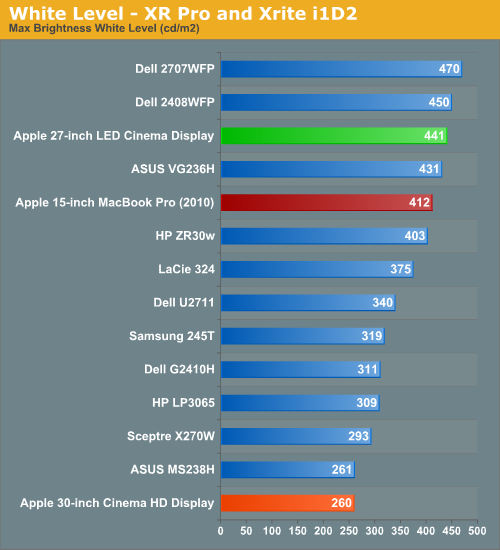
The new 27-inch LED Cinema Display is bright. It's within 10% of the 2707WFP and brighter than Dell's CCFL backlit U2711, which has a similar panel to what Apple uses in the 27-inch LED Cinema Display. If you're a fan of very bright displays, the 27-inch won't disappoint. I tossed in my 30-inch Cinema HD Display results as a reference point but keep in mind this is a very old unit (originally purchased in 2004) so it's not going to perform quite as good as it did while new.
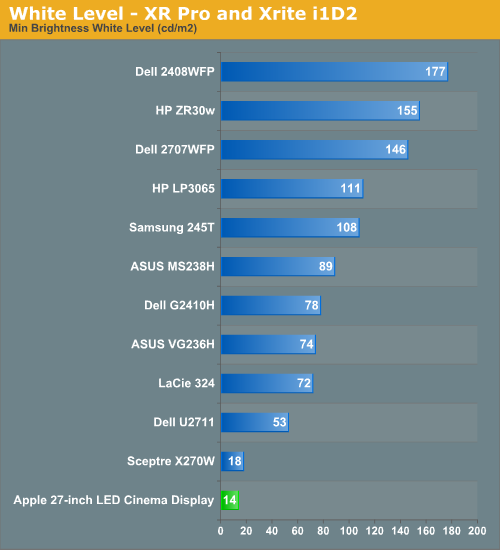
Drop brightness all the way and the 27-inch LED Cinema Display gets dim. There's a good amount of dynamic brightness range on this display, it's very flexible.
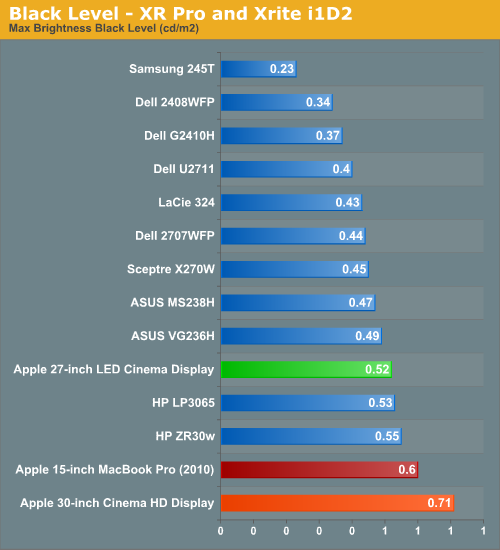
Absolute black levels are simply ok, not stellar for a high end display but not horrible either. It's clear Apple optimized for maximum brightness rather than deep blacks in order to compensate for the glossy front cover.
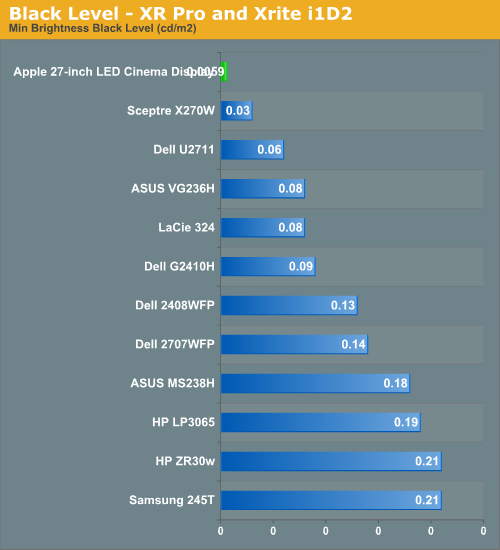
At the lowest measurable brightness setting the black levels are very low. You can actually get the display dark enough for my eyeOne D2 to register 0 nits. I had to bump brightness up a bit just to get the black level to register.
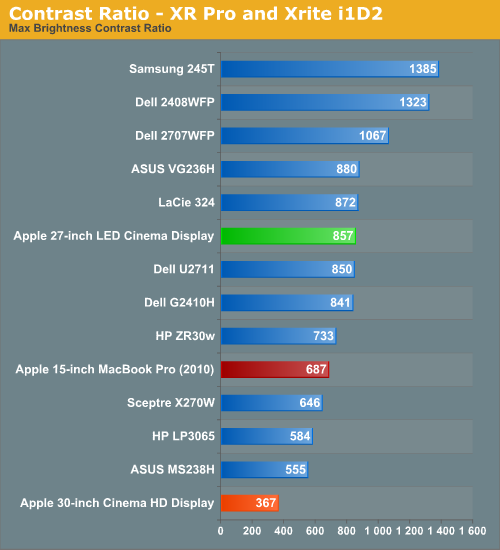
This isn't terrible but I would've liked to see something above 1000:1. Again it's sort of middle of the road for a high end display. Note that even at 200 nits the contrast ratio is 837:1, so unless you significantly reduce brightness you won't see a huge difference in contrast ratio.
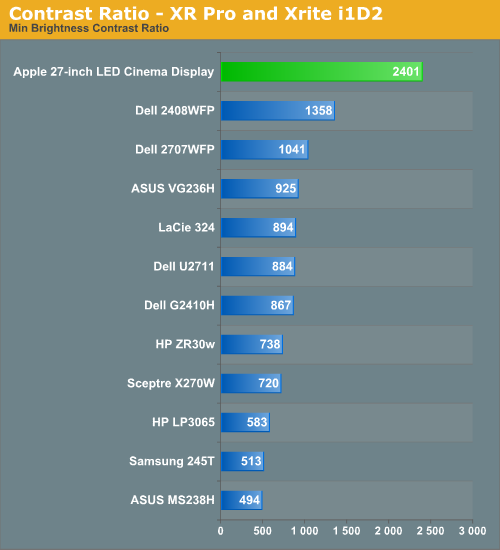
Thanks to very low black levels at the lowest brightness settings the contrast ratio skyrockets. As I mentioned before, at 200 nits the contrast ratio is still down at 837:1 so the numbers above aren't very real world unless you like using very dim displays. You can also count on the 27-inch display being quite usable at lower brightness settings as a result.










93 Comments
View All Comments
Hln98 - Tuesday, September 28, 2010 - link
Does the system fonts on this appear too small like the iMac 27 inch? I have the Apple 24 inch LED now and love it since I can see the font. I want to get the new 27 inch but if it's like the iMac 27 inch, I will pass.Please confirm.
Ogopogo - Tuesday, September 28, 2010 - link
I guess the Apple premium (perhaps excepting accessories) has really gone away over the years. Now all the major manufacturers have the same business model - a little distinctive design then outsource to Asia - so prices come back a wash. I remember when Apple wanted $1-2k more for their 30" monitor than anyone else. Now this comes in cheaper than the Dell U2711.Juddog - Tuesday, September 28, 2010 - link
I don't understand why the manufacturers are pushing for such high density displays - for me, 1920 x 1200 at 27 inches is the ideal resolution. Mostly because of font sizes and such, 2560 x 1440 just makes things seem too dang small.I don't known if it's a factor of getting old, but most people I work with seem to think the same.
Spivonious - Tuesday, September 28, 2010 - link
It's because things just look better at a higher DPI. If the fonts are too small, change the font size. Windows 7 has great support for this. My old 17" CRT (I'm too picky to use a TN panel LCD, and too cheap to spend $1000 on a nice IPS LCD) is 130dpi and things just look so much clearer when I run Windows at 125% font size. The number of apps that don't recognize the setting is much smaller than it used to be. Pretty much all apps that were released in the past 5 years support high DPI.I can actually see large differences at 12pt between fonts like Arial, Cambria, and Verdana, where on 96dpi they were very slightly different.
DanaG - Wednesday, September 29, 2010 - link
I have a high-dpi display, and can't use any desktops, because they all have crap DPI.<link removed because the damn comment system thinks this comment is spam>
Anyway, it was "rant-hdtv-has-ruined-the-lcd-display-market-or-i-want-my-pixels-and-dpi-now"
See my comment near the bottom.
"This comment is apparently spam and we do not allow spam comments."
What the hell, Anandtech? What sort of garbage do I have to put in my post to get it to not count as "spam"? How about more random words? Damnit...
n0x1ous - Tuesday, September 28, 2010 - link
I wish someone would make a 30 inch 2560 x 1600 TN so I could actually afford one. Im surprised Asus or Alienware or one of those doesn't get with some OEM and make a $500 30 inch TN for us gamers who don't need all the perfect viewing angles/colors etc......I am ready for more rez (currently on 19x12) but just can't stomach the 10 benjamins to get to 25x16
Tros - Tuesday, September 28, 2010 - link
I disagree, strongly.Your display is just as important as what video card you have driving it, simply because if you're in dark corridors, and the viewing angle makes more of a difference than the video card, then the rendered picture is worthless. Likewise, vibrant colors tend to get a faster response from the brain than colors that are washed out and leave the image ambiguous without looking at it for a few seconds.
I've got two solutions:
1) Go with a projector. Variable screen size, plus a low resolution to keep frames high.
2) Stick with the stuff in your price range.
It's this kind of demand that gets us huge, high resolution screens, with images worse than current solutions.
I'm disappointed with this offering from Apple, because it really is all-glitz and not much substance. As a consumer, I expect to pay a price and get a superior product. And I acknowledge that the price is ridiculous, but at least I don't have to play the "mixed bag" game. I am not wow'ed by the ability to pay a lower price and get something "like good". That's not Apple-like at all.
TegiriNenashi - Tuesday, September 28, 2010 - link
Second it. The price of 30" has been frozen at ~$1200 level for what, 3 years already? Those who claim that the cost of IPS panel is high, should look no further than LCD TVs, which prices steadily declined in all size categories. Today one can buy two good-enough 46" TVs (they are IPS!) for a price of one 30" monitor.BZDTemp - Thursday, September 30, 2010 - link
It's harder to make more pixels perfect so some of the cost is found there but it's also a question of to little a market so that mass production effects are limited.To many people are simply content with what they got and the majority looks at screen size vs. prices and then get the terrible TN panels. It's like in the old days with CRT's where most people ran them at 60 Hz because that was Windows default not knowing good screens could do so much better.
Dustin Sklavos - Tuesday, September 28, 2010 - link
Disagree. TN technology starts to really hit limitations at around 24", when you get bigger than that you start to lose uniformity and the sweet spot for viewing gets that much harder to find. A 30" TN panel would look awful.